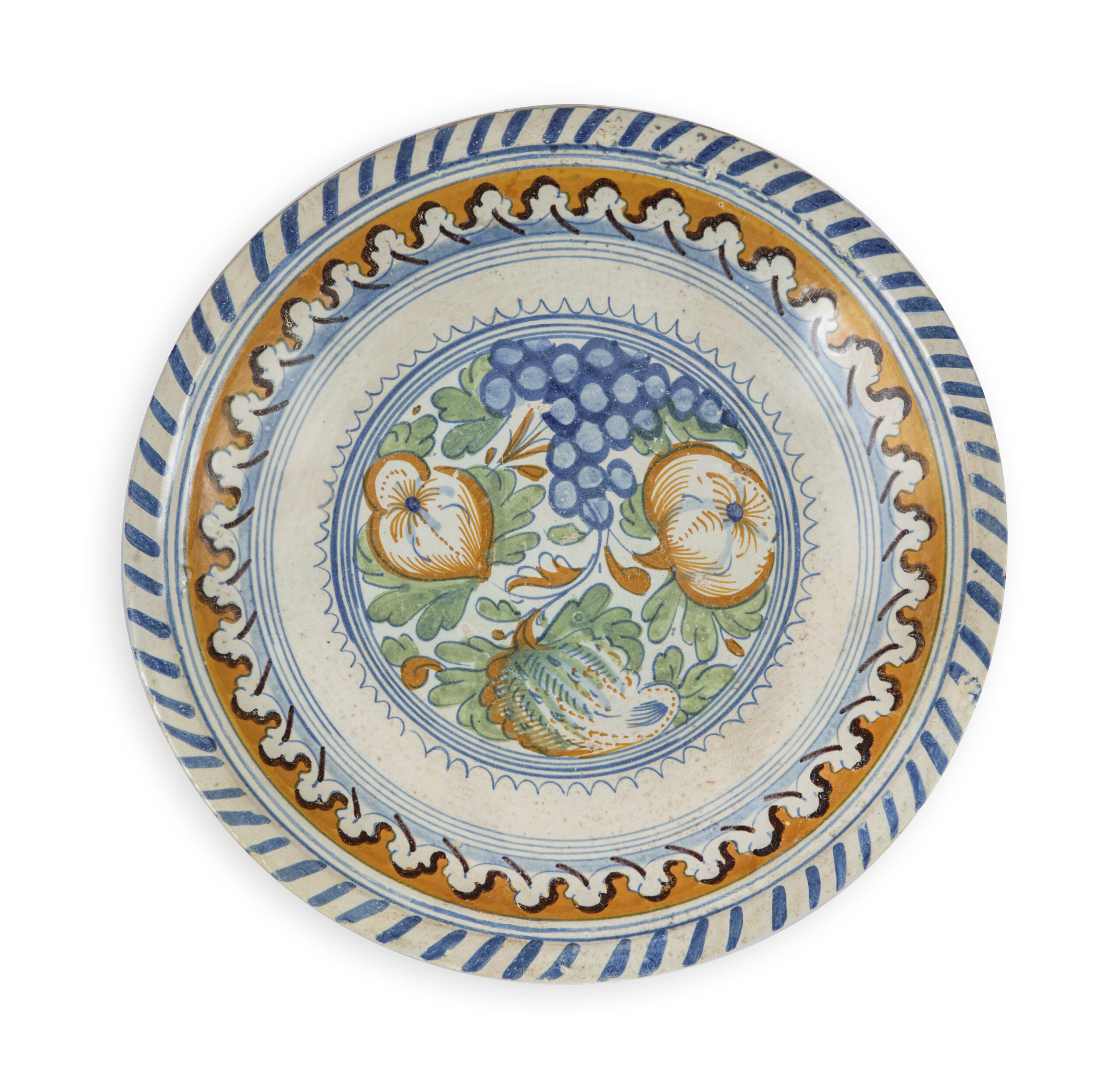[popup_trigger id=”13756″ tag=”span”]![]() [/popup_trigger]
[/popup_trigger]
Images on this website are licensed under a
Creative Commons Attribution-NoDerivs 3.0 Unported License.
OBJECT
D2201. Majolica Polychrome Charger
Haarlem, circa 1630
Unidentifiably marked with an F in blue
Painted in the center in yellow, green and blue with an apple, a pomegranate, a bunch of grapes, a striped melon and foliage within a roundel of four concentric lines edged with a scalloped line, the rim with a yellow border reserved with a band of foliate scrolls, three concentric blue lines and a blue dashed edge, the reverse lead-glazed.
DIMENSIONS
Diameter: 31.8 cm. (12.5 in.)
PROVENANCE
The R.J. Bois Collection, North-Holland
NOTE
Dutch majolica is the forerunner of Delftware. In the late sixteenth century potters of Italian origin migrated from Antwerp to the Northern Netherlands due to religious and political turmoil (the Fall of Antwerp in 1585). These potters settled in cities such as Haarlem and Delft, bringing with them their knowledge and skills in making Italian- style tin-glazed earthenwares (maiolica). The early Netherlandish majolica production consisted mainly of dishes and porridge bowls covered on the front in an opaque white tin glaze, and on the reverse with a less costly transparent lead glaze. The decoration of these pieces in either European patterns or imitations of ‘kraak’ porcelain (the first type of Chinese export porcelain from the Wanli period [1573-1620] to be imported into the Netherlands), or a combination of both, was painted predominantly in blue, yellow, orange or ochre, green and manganese, colors derived from mineral oxides.
Majolica can be distinguished from Delftware not only by the clear glaze on the reverse, revealing the buff-colored body of the clay, but also by the three small spots of glaze damage on the front (prunt marks). These were created by the stacking of the pieces on top of one another in the kiln, separated by ceramic triangles that had to be broken away after the firing. In that process, the points where the triangles had rested would leave their mark: a small unglazed scar.
Majolica was usually painted with similar themes found in Dutch paintings, with still lifes and biblical scenes being the most common subjects. Southern fruits, such as pomegranates, bunches of grapes and apples, were often painted on a background of leaves in still life scenes. The inspiration for this motif was probably the Venetian majolica of the first half of the sixteenth century. According to Scholten, 1993, p. 25, it is pointless to seek meaning in such decorations. Nonetheless, one can assume that the contemporary audience understood the symbolism of pomegranates. The pomegranate, a native fruit of the Eastern Mediterranean lands, is a subject and symbol in many of the Ancient cultures of the region. The Egyptians considered it a symbol of prosperity, and understood its medicinal properties. In Greek mythology, the pomegranate, thought to have sprung from the blood of the god Adonis, was known as the “fruit of the dead,” and it appears with various good and evil properties in numerous myths.
SIMILAR EXAMPLES
Majolica dishes and chargers with a somewhat central subject of grapes, melons and pomegranates are illustrated in Scholten 1993, p. 59, no. 49, p. 61, no. 51, p. 63, no. 52 and p. 73, no. 61, and by Biesboer 1997, p. 73, no 76, who on p. 64 discusses this type of pomegranate decoration, which he suggests came from sixteenth-century Venetian maiolica, and appeared in Holland around 1590, reaching the height of its popularity in the first quarter of the seventeenth century. Although the present charger’s central scene is not uncommon, the rare elaborate rim decoration and especially the arches in the yellow border make this charger unique.









